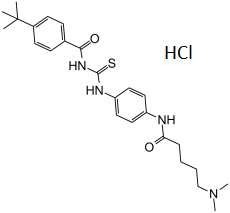Tenovin-6 is an analog of tenovin-1 with more water-soluble and it inhibits the protein deacetylase activities of SIRT1, SIRT2 and SIRT3 with IC50 value of 21 μM, 10 μM, and 67 μM, respectively. It has been determined that the cytotoxic effects of tenovin-6 may happen via autophagy dysregulation rather than apoptosis induction in chronic lymphocytic leukemia cells. In mammalian cells, tenovin-6 may have sir2p homologs as a target. In vitro, tenovin-6 reduces the activity of the purified human SirT1 peptide deacetylase with an IC50 value of 21 mM and the human SirT2 activity with a value of 10 mM.
Physicochemical Properties
| Molecular Formula | C₂₅H₃₅CLN₄O₂S |
| Molecular Weight | 491.09 |
| Exact Mass | 490.216 |
| Elemental Analysis | C, 61.14; H, 7.18; Cl, 7.22; N, 11.41; O, 6.52; S, 6.53 |
| CAS # | 1011301-29-3 |
| Related CAS # | Tenovin-6;1011557-82-6 |
| PubChem CID | 49871498 |
| Appearance | Yellow solid powder |
| Hydrogen Bond Donor Count | 4 |
| Hydrogen Bond Acceptor Count | 4 |
| Rotatable Bond Count | 9 |
| Heavy Atom Count | 33 |
| Complexity | 616 |
| Defined Atom Stereocenter Count | 0 |
| SMILES | Cl[H].S=C(N([H])C1C([H])=C([H])C(=C([H])C=1[H])N([H])C(C([H])([H])C([H])([H])C([H])([H])C([H])([H])N(C([H])([H])[H])C([H])([H])[H])=O)N([H])C(C1C([H])=C([H])C(=C([H])C=1[H])C(C([H])([H])[H])(C([H])([H])[H])C([H])([H])[H])=O |
| InChi Key | UBNCTIDXQDCEPI-UHFFFAOYSA-N |
| InChi Code | InChI=1S/C25H34N4O2S.ClH/c1-25(2,3)19-11-9-18(10-12-19)23(31)28-24(32)27-21-15-13-20(14-16-21)26-22(30)8-6-7-17-29(4)5;/h9-16H,6-8,17H2,1-5H3,(H,26,30)(H2,27,28,31,32);1H |
| Chemical Name | 4-tert-butyl-N-[[4-[5-(dimethylamino)pentanoylamino]phenyl]carbamothioyl]benzamide;hydrochloride |
| Synonyms | Tenovin-6 HCl; Tenovin6; Tnv-6; Tenovin 6; Tenovin-6 |
| HS Tariff Code | 2934.99.9001 |
| Storage |
Powder-20°C 3 years 4°C 2 years In solvent -80°C 6 months -20°C 1 month Note: Please store this product in a sealed and protected environment, avoid exposure to moisture. |
| Shipping Condition | Room temperature (This product is stable at ambient temperature for a few days during ordinary shipping and time spent in Customs) |
Biological Activity
| Targets | SIRT2 (IC50 = 10 μM); SIRT1 (IC50 = 21 μM); SIRT3 (IC50 = 67 μM); HDAC8; MDM-2/p53 | |||
| ln Vitro |
Tenovin-6 Hydrochloride is more toxic to yeast than the less water-soluble tenovin-1, with an IC50 of 30 M for inhibiting the growth of S. cerevisiae cultures. In MCF-7 cells, endogenous K382-Ac p53 levels are quickly elevated by tenovin-6 hydrochloride[1]. Tenovin-6 Hydrochloride (0 to 15 μM) dose dependently increases the level of LC3-II in diverse cell types, and the increase is ATG5/7 dependent. In addition, the use of tenovin-6 hydrochloride prevents SQSTM1/p62 degradation caused by torin 1 and boosts the quantity and intensity of autophagic vesicles both with and without torin 1. The fusion between autophagosomes and lysosomes is unaffected by tenovin-6 hydrochloride, but it affects the acidification of autolysosomes and hinders lysosome hydrolytic activity. Tenovin-6 Hydrochloride inhibits autophagy, but this is unrelated to p53 activation, and inhibiting SIRT1/2 either through knockdown or knockout cannot mimic Tenovin-6 Hydrochloride's effect on LC3B accumulation[3]. Tenovin-6 Hydrochloride (0, 1, 2.5, 5 or 10 μM) potently inhibits cell proliferation in a dose- and time-dependent manner in all OCI-Ly1, DHL-10, U2932, RIVA, HBL1 and OCI-Ly10 cell lines. Tenovin-6 Hydrochloride consistently raises the level of LC3B-II in DLBCL cell lines by blocking the traditional autophagy pathway without turning on p53, and the rise is unrelated to SIRT1/2/3 or p53. Through the extrinsic cell-death pathway, tenovin-6 hydrochloride causes apoptosis[4]. Tenovin-6 Hydrochloride inhibits UM cell growth with IC50 values of 12.8 μM, 11.0 μM, 14.58 μM and 9.62 μM for 92.1, Mel 270, Omm 1, and Omm 2.3 cells, respectively[5]. |
|||
| ln Vivo | Tenovin-6 Hydrochloride (50 mg/kg, i.p.) inhibits the growth of tumor in mice[1]. | |||
| Enzyme Assay | The Fluor de Lys Fluorescent Assay Systems perform assays using purified components. Useful FdL substrates are used at a concentration of 7 M, and NAD+ is used at a concentration of 1 mM. Tenovins are soluble in DMSO with a final DSMO concentration in the reaction being less than 0.25%. One unit of the enzyme is used in each reaction for SirT1 and HDAC8, and five units are used in each reaction for SirT2 and SirT3. For one hour, reactions are conducted at 37°C. | |||
| Cell Assay | The MTS assay is used to evaluate cell viability. In 96-well plates, UM cells are seeded into each well (5,000 cells/well), treated the following day with control or Tenovin-6 in increasing concentrations from 0 to 20 M for 68 h, and then MTS is added at 20 L/well to be read at a wave length of 490 nm. The IC50 is calculated by curve fitting the sigmoidal dose-response curve. | |||
| Animal Protocol |
|
|||
| References |
[1]. Discovery, in vivo activity, and mechanism of action of a small-molecule p53 activator. Cancer Cell. 2008 May;13(5):454-63. [2]. Exploitation of DHODH and p53 activation as therapeutic targets - a case study in polypharmacology [published online ahead of print, 2020 Sep 8]. J Biol Chem. 2020;jbc.RA119.012056. [3]. Class III-specific HDAC inhibitor Tenovin-6 induces apoptosis, suppresses migration and eliminates cancer stem cells in uveal melanoma. Sci Rep. 2016 Mar 4;6:22622. [4]. Tenovin-6 impairs autophagy by inhibiting autophagic flux. Cell Death Dis. 2017 Feb 9;8(2):e2608. [5]. Tenovin-6 inhibits proliferation and survival of diffuse large B-cell lymphoma cells by blocking autophagy. Oncotarget. 2017 Feb 28;8(9):14912-14924. |
Solubility Data
| Solubility (In Vitro) |
|
|||
| Solubility (In Vivo) |
|
| Preparing Stock Solutions | 1 mg | 5 mg | 10 mg | |
| 1 mM | 2.0363 mL | 10.1814 mL | 20.3629 mL | |
| 5 mM | 0.4073 mL | 2.0363 mL | 4.0726 mL | |
| 10 mM | 0.2036 mL | 1.0181 mL | 2.0363 mL |
